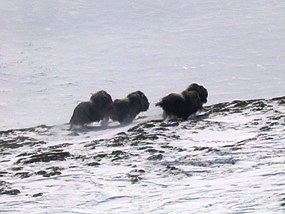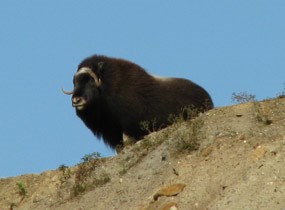|
Muskox | Designed for the Arctic | Food and Family | Circle Defense | 
USFWS Life in the Deep Freeze Muskoxen are beautifully adapted to extreme arctic conditions. They live on open, unsheltered tundra, enduring shuddering gales, blowing snow and temperatures of –40 degrees or colder in the winter. One key to their hardiness is their extraordinary fur which consists of two layers. The very long outer hair is the longest fur of any North American animal; and the thick wooly coat of underfur—known by the Eskimo name Qiviut—is eight times warmer than sheep’s wool. Qiviut is also much more durable than wool, yet it is finer than cashmere. Except for its lips and nostrils, every exposed part of a muskox is thickly wrapped in fur. The animals shed their underfur in summer, when loose clumps hang from the coat and sometimes get caught on willow bushes. Some native people gather the qiviut and spin it into beautiful, soft, lightweight yarn. Other adaptations to cold include a barrel-shaped body and short legs, which reduce the ratio of body mass to surface area, minimizing heat loss. Muskoxen can be up to seven feet long with short legs and broad, stout cloven hooves, giving them a long, thick, brawny build. Bulls are around five feet tall at the shoulder and weigh 600-800 pounds, and the cows reach about four feet tall and weigh 400-500 pounds. 
NPS photo by Jim Lawler Muskoxen also have an excellent sense of smell which is important for finding food under the snow. They can survive on an extremely spare diet of tundra plants, including dried grasses, sedges and willows. In the winter, they favor places with shallow snow cover—which often means windy places where snow blows away but the wind chill is extreme. Muskoxen use their front hooves to dig through snow for food. They also lift and drop their head to break through crusted snow, and then scoop chunks away with their hooves. In winter, muskoxen conserve heat and energy by minimizing activity: They spend much of their time resting, sleeping and digesting their daily intake of low-quality plants. When arctic blizzards rage across the treeless land, they lie down with their back to the gale. Unlike migratory caribou, muskoxen prefer to stay put, often spending the winter in a home area measuring less than a square mile. 
Richard Nelson Muskox and the Melting Arctic There are perhaps as many as 130,000 muskoxen in the world today, mostly in Canada, with smaller populations in Greenland, Alaska, Russia and Norway. These animals are thriving and they offer an excellent chance to continue establishing herds in other parts of the arctic. One exception is the Alaskan North Slope where the population is declining and biologists are not sure why. A serious overall concern for muskoxen is the rapidly warming arctic climate, which is likely to cause wholesale changes in tundra ecology. This includes forests spreading northward, displacing the essential habitat for tundra animals like muskoxen and caribou. There are also more immediate concerns, especially about winter thaws and rains followed by freezing temperatures that create a thick crust on the snow. When this happens, their food is locked under the icy crust. These conditions are especially challenging for calves. The muskox is a fascinating and uniquely beautiful survivor. Watching one of these animals in Gates of the Arctic National Park is a chance to experience both the ancient Ice Age world and the enduring wildness of modern Alaska. It is also a reminder of our privilege and responsibility to preserve the environment on which these remarkable animals depend. Muskox | Designed for the Arctic | Food and Family | Circle Defense | |
Last updated: December 16, 2020
